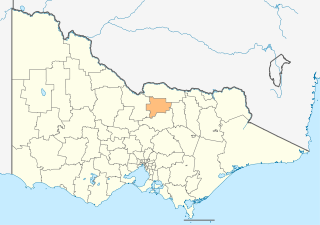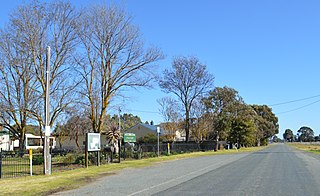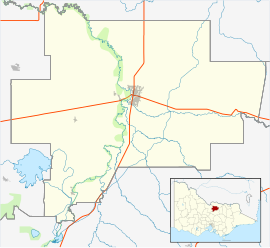
Shepparton is a city located on the floodplain of the Goulburn River in northern Victoria, Australia, approximately 181 kilometres (112 mi) north-northeast of Melbourne. As of the 2021 census, the estimated population of Shepparton, including the adjacent town of Mooroopna, was 53,841.

The City of Greater Shepparton is a local government area in the Hume region of Victoria, Australia, located in the north-east part of the state. It covers an area of 2,422 square kilometres (935 sq mi) and, in August 2021, had a population of 68,409. It includes the city of Shepparton and the towns of Arcadia, Ardmona, Congupna, Dookie, Grahamvale, Kialla, Lemnos, Merrigum, Mooroopna, Murchison, Tallygaroopna, Tatura, Toolamba and Undera. It was formed in 1994 from the amalgamation of the City of Shepparton, Shire of Shepparton, and parts of the Shire of Rodney, Shire of Euroa, Shire of Goulburn, Shire of Tungamah, Shire of Violet Town and Shire of Waranga.

Hay is a town in the western Riverina region of south western New South Wales, Australia. It is the administrative centre of Hay Shire local government area and the centre of a prosperous and productive agricultural district on the wide Hay Plains.

Seymour is a town located in the Southern end of the Goulburn Valley in the Shire of Mitchell, Victoria, Australia and is located 104 kilometres (65 mi) north of Melbourne. At the 2021 census, Seymour had a population of 6,569. The township services the surrounding agricultural industries as well as the nearby military base of Puckapunyal, which is an important training centre for the Australian Army. Other important sectors of employment in Seymour include retail, light engineering, agricultural services support, medical services, and education.

Mooroopna is a town located 181 kilometres (112 mi) north of Melbourne, Victoria, Australia. It is on the banks of the Goulburn River opposite the larger town of Shepparton. The Midland Highway crosses the river between the two towns. On the 30th June 2022, Mooroopna had a population of 8,921.

Goulburn Valley Highway is a highway located in Victoria, Australia, linking Tocumwal on the Murray River through North Central Victoria to Eildon. The section north of the Hume Freeway is part of the Melbourne to Brisbane National Highway and is the main link between these two cities, as well as a major link between Victoria and inland New South Wales. It is also the most direct route between Melbourne and the major regional centre of Shepparton in Victoria.

Tatura is a town in the Goulburn Valley region of Victoria, Australia, and is situated within the City of Greater Shepparton local government area, 167 kilometres (104 mi) north of the state capital (Melbourne) and 18 kilometres (11 mi) west of the regional centre of Shepparton. At the 2021 census, Tatura had a population of 4,955.

The Goulburn Valley is a sub-region, part of the Hume region of the Australian state of Victoria. The sub-region consists of those areas in the catchment of the Goulburn River and other nearby streams, and is part of the Murray-Darling Basin. The Goulburn Valley is bordered on the south by the Great Dividing Range and to the north by the Murray River, the state border with New South Wales. The sub-region is one of Australia's most productive and intensively farmed areas and is predominantly irrigated.
In customary international law, an enemy alien is any alien native, citizen, denizen or subject of any foreign nation or government with which a domestic nation or government is in conflict and who is liable to be apprehended, restrained, secured and removed. Usually, the countries are in a state of declared war.

Nagambie is a town in the Goulburn Valley region of Victoria, Australia. The city is on the Goulburn Valley Freeway north of Seymour and in the Shire of Strathbogie. As of 2021 census, Nagambie had a population of 2,254.

Barham is a town in the western Riverina district of New South Wales, Australia. The town is located 823 kilometres south west of the state capital, Sydney and 303 kilometres north west of Melbourne. Situated on the banks of the Murray River across from Koondrook in the neighbouring state of Victoria, Barham had a population of 1,159 at the 2016 census. The town is in the Murray River Council local government area.
Camp 14 was one of three main prisoner of war and internee camps in South Australia.
Camp 10 was one of three main prisoner of war and internment camps in South Australia which were used during WWII to contain both prisoners of war and innocent civilians who happened to be of German, Italian, or Japanese heritage. All three camps were located near Loveday, in South Australia'sRiverland, with Camp 10 approximately 12 kilometres from Renmark.

The Hay Internment and POW camps at Hay, New South Wales, Australia were established during World War II as prisoner-of-war and internment centres, due in part to the isolated location of the town. Three high-security camps were constructed in 1940. The first arrivals were 2,542 internees from Nazi Germany and Austria, most of whom were Jewish; they had been interned in the United Kingdom as enemy aliens when the possibility of an Axis invasion of Britain was at its highest.

Days Mill and Farm comprises an historic steam-driven flour mill, farm and homestead at Murchison South, Victoria, Australia constructed in 1865 by William and Anne Day. The mill is the best preserved 19th century flour mill in Victoria and a remarkably intact heritage site.

Ngooraialum were an indigenous Australian tribal subgroup, one of 3 comprising the Ngurai-illam Wurrung, though Norman Tindale placed them among the Taungurung. They inhabited land along the Goulburn River in central Victoria, north of Mitchellstown, at Murchison, above Toolamba, within 40 miles (64 km) of the Murray-Goldburn junction. The heart of their land was Noorillim, which they called Waaring.

Dhurringile is a small town in Victoria, Australia, located 10 km north of Murchison and approximately the same distance east of the Waranga Basin reservoir. It is located in the City of Greater Shepparton. At the 2021 census, Dhurringile had a population of 369..
Italian prisoners of war in Australia were Italian soldiers captured by the British and Allied Forces in World War II and taken to Australia.

The Italian National Ossario, also known as the Murchison Ossario, is an ossuary, war cemetery and war memorial in Murchison, a town in the Goulburn Valley region of Victoria, Australia. The ossario holds the remains of 130 Italians interned during World War II.


















